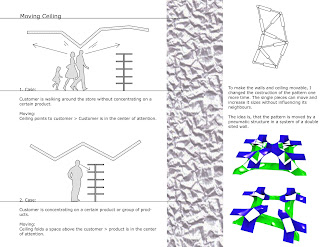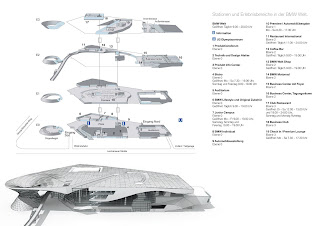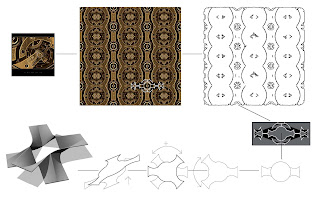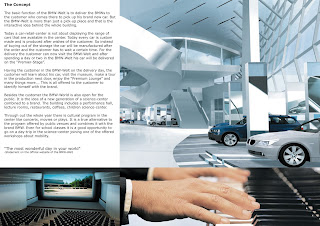
SONY Retail Store

Customers walking through the store will be recognized by the ceiling, which transfers there movements into different shapes. They are simple movements for a single customer, but when the store is crowded with customers, the ceiling will form shapes like a crumbled paper. Especially when to customers cross or step close to each other with different intentions, these intersections in the ceiling will create a interesting shape.
Pattern-Animations
The single peace of the pattern slides apart and increases it size in 2 dimensions.
Putting this single element together and allow it to fold and bend, I got a high flexible peace for creating a pattern that is able to move in all directions and increase seperate parts of it wherever it is requiered.
This animation shows how the pattern can increase/decrease it size.
2. Moving Building

The products in the store are presented on "presentations-islands". These islands are surrounded by a skin which is made out of the pattern.
At daytime this skin creates a space around the islands. The customer is welcome to enter the space and experience the world of SONY. Everything else, that is needed for the shop (Cashier, seats,...) will be folded by the skin.
At nighttime the skin folds up around the islands and creates a roof inbetween the islands. Now the customer is still able to see the products even at nighttime.
The islands can be relocated every morning according to the needs of the customer, the products and events by SONY. The movements of the ceiling during the day are captured by a program which calculates for example average or interesting moments. With these changes over the day, the building will fold up and down differently every day.
Renderings
Animation
This animation shows the change from daytime to nighttime. It is just one possibility how it could fold up. The folding will change every day according to the path-history of the customers and the location of the islands.
The hall is a marketplace for differentiated and changing uses and an unmistakable sign for the BMW Group.
The interior topography creates differentiated spatial densities and fluid subspaces.
The heart of the building is the "Premiere" vehicle delivery area. Hanging above this space are the customer lounges which allow views through the event space and toward the BMW headquarters.


Please click on the pictures to read more
3D-Pattern-Process

Pinboard
1: To set the rules for the movements on my pinboard, I invented a schedule for the two occupants. To keep it simply and basic I decided to choose a pretty normal day of a couple.
Having set up a schedule for my inhabitants, I moved on transvering the schedule on the pinboard.
2: Transfering the movement the inhabitants have to make for their daylife, the animation saves the paths and shows a obvious arrangement of the spaces needed for their actions.
3: With the results from the first pinboard I organized the minimun spaces that are needed for every type of action. All spaces have a distance of one square in between.
4: Folowing the same schedule again and the simple rule, that any space expands by one square in all directions in case of being occupied, the second animation shows how the spaces could react to the users movements.
Spaces
Organizing minimum spaces
Paths
Schedule
Pattern-Animations
The following movies show the movements of an interactive pattern.
Bottom: This is one of my first tries and shows how flexible the pattern is and what limits are given through the structure.
Top: This video is a translation from my studies with the pinboards. It shows how the pattern could react to the actual movements of the inhabitants. Every time a space is occupied the pattern forms a shell and creates the spaces that is specifacly needed by the occupand(s). When a space is not in use it shrinks to its normal shape.















